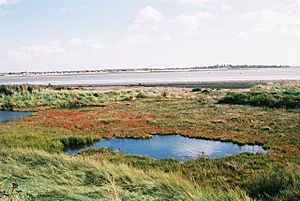Colne Estuary facts for kids
| Site of Special Scientific Interest | |
 |
|
| Area of Search | Essex |
|---|---|
| Interest | Biological Geological |
| Area | 2915.2 hectares |
| Notification | 1989 |
| Location map | Magic Map |
|
Designations
|
|
| Official name: Colne Estuary | |
| Designated: | 28 July 1994 |
|---|---|
| Reference #: | 665 |
The Colne Estuary is a very special natural area in Essex, England. It covers a huge area of about 2,915 hectares (that's over 7,000 acres!). This place is important for both its amazing wildlife (biology) and its ancient rocks and landforms (geology).
It's recognized by many important groups. For example, it's a Site of Special Scientific Interest (SSSI). This means it's one of the best places in the country for wildlife or geology. It's also a Ramsar wetland, which means it's super important for birds and water on a global scale. Plus, it's a National Nature Reserve, a Special Protection Area, and a Special Area of Conservation.
Three parts of the Colne Estuary are looked after by the Essex Wildlife Trust. These are Colne Point, Fingringhoe Wick, and Howlands Marsh. They help protect the animals and plants that live here.
Contents
What Makes Colne Estuary Special?
The Colne Estuary has many different types of natural areas. These include salty marshes, wide mud flats, and long stretches of shingle (small stones). There are also old gravel pits that have filled with water. This mix of habitats makes it a perfect home for many different creatures.
A Haven for Birds
This estuary is incredibly important for birds, especially in winter. It's a key stop for thousands of brent geese and black-tailed godwits. These birds travel long distances to feed and rest here.
Six other bird species also find the estuary very important. This includes the small and quick little terns. Birdwatchers love to visit and see all the different species.
Amazing Plants and Tiny Creatures
Beyond the birds, the Colne Estuary is home to many interesting plants. You can find plants like golden samphire and shrubby seablite. These plants are specially adapted to live in salty environments.
The area also has many different kinds of invertebrates. These are small creatures without backbones, like insects and crabs. They form an important part of the estuary's food web.
Clues from the Past: Geology
The Colne Estuary also holds secrets from Earth's ancient past. In a place called St Osyth Marsh, scientists found a layer of peat. Peat is made from old, decayed plants. This peat layer is about 4,280 years old! Studying it helps us understand how the marsh has changed over thousands of years.
Ancient Climates at East Mersea
At East Mersea, there are important geological sites. These sites help scientists study the Pleistocene epoch. This was a time when Earth experienced many ice ages.
The rocks and soil layers here show signs of warmer periods. These warm times happened between the ice ages. Scientists are still studying these layers. They hope to learn more about how Earth's climate has changed over long periods.

